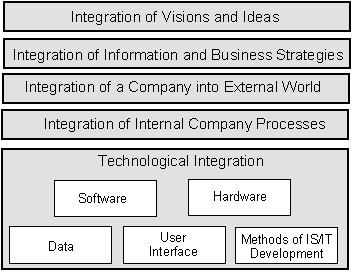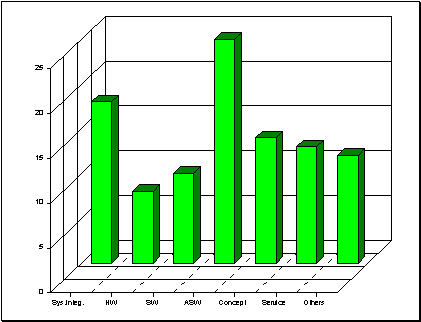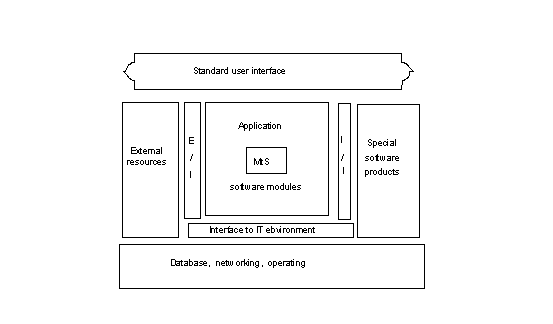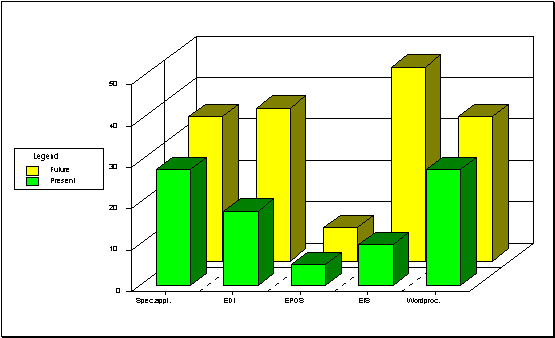SYSTEMS INTEGRATION
IN THE CZECH PRACTISE
Jan Pour and Jiří
Voříšek
Prague University
of Economics
Department of
Information Technologies
W. Churchill Sq. 4
130 67 Prague 3
Czech Republic
Published: October 1996
Key words: Information system, application software package,
systems integration, prototyping,
software architecture, information technologies.
Abstract: The paper is
dealing with some problems of IS/IT development in a company. The first one are
the scope and levels of the systems integration. The second one is a role of
application software package (ASW) in the systems integration.. The last part
of the paper summarizes some trends of application software packages having to
determine the new perspectives of IS/IT.
The Goals and Means of Systems Integration
Systems integration is a trend enforcing itself in the
world of computers with the great dynamic. Its significance in solving the
current problems of information systems is quite apparent.
Systems integration is a specific way of IS/IT
development. Its goal is to create and
maintain a complex and integrated IS/IT of a company by means of integration of various components and services of different
suppliers.
When we are talking about a complex and integrated IS/IT
then we mean such IS/IT that:
· supports business goals and priorities of a company,
· gives complex and relevant information both of the
company and its development, and of the external environment of the company
(clients, suppliers etc.),
· supports all relevant business processes both internal
(financial management, manufacturing, personal management, stocks, sales and
purchase analysis) and external (on-line links to clients, suppliers, banks
etc.),
· is integrated in all significant dimensions of IS/IT
(data, functions, software, hardware organizational aspects, qualification of
users, methods of development, implementation and operation) [Vorisek, Riha
1993],
· has a simple, well designed global architecture which
effectively combines various IT architectures (e.g. three tiers architecture,
client/server architecture, distributed architecture),
· is built as a construction of interconnected application
software packages and specialized software modules, frequently from various
developers (software houses),
· is usually based on the heterogenous hardware aimed to
reach the most effective relation price/performance and to gain an independence
on the only one IT manufacturer,
· has a standardized user interface,
· is usually built as a distributed system with an optimal
location of data and procedures within a network.
Information system of the features mentioned above is
permanently being developed by an
integrated complex of activities, including:
· making an information strategy,
· the design, implementation, and installation of
different IS projects formulated in the information strategy and completing
separate building block of the global IS/IT architecture,
· the installation and integration of hardware and
technological software (operating systems, database management systems, office
information system etc.),
· the training of all types of users,
· the permanent consultation for users (hot-line),
· the management of IS/IT operation,
· the management of IS/IT maintenance and further
development.
These activities are based on various methodologies,
methods, and adequate CASE tools [Vorisek, Pour, 1994].
Levels of Systems Integration
In practice, the systems integration is understood very
differently. It is restricted often only to integration of various hardware and
software components of IS/IT. In the MDIS methodology (Multidimensional
Development of IS/IT [Vorisek, Riha, 1993]), which is being developed at our
department, the systems integration includes more levels - see Fig.1.

The first level is the
integration of visions and ideas of company top managers. This kind of
integration is produced during brainstorming and common discussions of
managers, event. with external
consultants.
Such discussions are basically aimed at specification of
the role of IS/IT for business and creation of value system of a company,
respectively genetic code of organization [Voříšek,1993]. The consistent value
system and the well defined role of IS/IT in a company are very significant for
formulating and implementing of strategic intentions in IS/IT. If the
integration at this level is not achieved it is very likely that the
investments in IS/IT will not result in any benefit.
The integration of
an information strategy with the business strategy is the second level of integration. The integration of
both strategies is necessary in order to support the business goals by the
IS/IT. The integration is achieved by following steps:
·
the requirements on
IS/IT, are derived from the SWOT
analysis and from the goals of a business strategy,
·
the requirements are
analysed and at the basis of this analysis the desired functions of IS/IT are
specified,
·
the functions and
connected data are divided into several blocks with limited number of links.
These block are the „stones“ of the IS/IT global architecture,
·
according to business
priorities separate IS projects are defined. The goal of each project is the
development/purchase and implementation of one block of IS/IT architecture and its integration into
existing IS/IT.
The integration of
a company into external word
is the next level of integration. The goal of this integration is to create
links between the company and its external partners (suppliers, customers,
banks, etc.) with the help of IS/IT. With the increasing role of the Internet, WWW, and other means of
communications this level of integration is more and more important.
The integration of
the internal company processes
is realized by the BPR (Business Process Re-engineering) and is aimed at
following goals [Donovan,1994]:
·
to shorten the time of the
processes in order to achieve quick response of a company to external events,
·
to minimize the use of
company resources during the processes,
·
to achieve the highest
quality of products and services by process optimization.
The last level of integration is the technological integration which includes:
·
the integration of various
hardware components from different vendors into company computer network,
·
the integration of the
software products that implement separate blocks of IS architecture,
·
the integration of all
databases of a company,
·
the standardization of
user interface,
·
the integration of
different methods and tools of IS/IT development.
Major Steps in Development of Integrated IS/IT
To create and maintain IS/IT which is integrated at all
levels mentioned above is very difficult task. It requires a lot of financial
and human resources. It is not possible for small and medium enterprises (and
very often for the large ones as well) to complete this task without external
help. Therefore, more and more enterprises develop their IS/IT with the help of
external firm - system integrator. If
this scheme of IS/IT development is used then the major steps are following:
1. Update of
business strategy according to the latest SWOT analysis
This step ensures that the information strategy will
take into account all main business goals, priorities, and requirements.
2. Development of
the information strategy
Development of the information strategy is crucial step
of whole procedure [Daniels,1994], because it is responsible for all five levels of IS/IT integration,
for the design of the global IS/IT architecture, and for the specification of
all IS/IT projects.
3. Call for tender
The document „Call for Tender“ is based on the
information strategy and its goal is to define all requirements on the system
integrator and its services. The main differences between the call for tender
and the information strategy are following:
·
it does not include such
information that could be abused by the competitors,
·
it includes precise
description of the desired structure of the proposal (if the proposals in the
tender are not in the same structure, it is very difficult or even impossible
to evaluate the proposals with the use of
the standard set of criteria),
4. Evaluation of
proposals with the use of a set of evaluation criteria
Evaluation criteria and their weights are another
success factors of the whole procedure. They are used in this step and
following three steps in order to select the best system integrator and the
best IS/IT components which will realize the role of separate blocks of IS/IT
architecure. In this step about 4 to 6 proposals are selected, the other are
rejected.
5. Evaluation of
references
The future customer of system integrator has to be sure
that the system integrator is not only able to write high quality proposal, but
also, that the software package functions will be efficient for the company and
that the system integrator is able to realize the projects in planned time and
within planned budget. The best way of evaluation of this criteria is to
analyze other implementations of the software package.
6. Evaluation of
presentations
Even if the references are excellent it does not give
the certainty that the implementation of
new IS/IT will be successful. Another success factor are the abilities
of the system integrator team. The presentation of a proposal is the first step
in evaluation of the team abilities. After this step only two system
integrators and their proposals advance to next evaluation step.
7. Feasibility
study
During feasibility study both system integrators obtain
all information necessary for design and implementation of the new IS/IT (they
get the information strategy, they do interviews with the management and
employees). The feasibility study has to main goals:
·
to update the proposal
according to new information and to develop a prototype of decisive parts of
future system,
·
to evaluate the
cooperation of the customer and system integrator team.
8. Contract
After evaluation of the feasibility studies the winner
of the tender is determined. Writing a contract with the winner of tender is the last step of the
tender process. The tender is followed by the realization of IS/IT projects
according to the feasibility study and contract.
Application Software - the Key Determinant for Systems
Integration
There are many criteria significant for the selection of
the best systems integrator of company’s IS/IT. For example we use in the
evaluation process set of more than one hundred criteria hierarchically
organized into several groups. The most important groups are following:
· references and other basic characteristics of a systems
integrator (Syst.integ.),
· the architecture of the proposed IS/IT (Concept),
· application software package and its functions (ASW),
· technological software products (databases, operating
systems, office information system,...- SW),
· hardware and communication network (HW),
· services, including training, consultancy, hot line,
etc. (Service).

The key point of these criteria and components of
systems integration is still the
application software package. The position of ASW in the development or
innovation processes of IS/IT also describes the ranking of significance of the
criteria defined for the evaluation of systems integrators' proposals (see the
graph in the Fig. 2). The percentage values are the means of weights which were
defined by the different customers, information managers and consultants during
15 Czech tenders, which the department of IT at PUE has been participating in.
The application software is still playing a decisive
role in the field of informatics. The quality of a systems integrator, the
quality and experience of its people, the number and significance of references
is the second most important success
factor of IS/IT. The global architecture of IS/IT is also one of the important
components. Hardware and technological software, despite of fast advances, are
not seen as a basically determining elements for the selection.
The business is very strongly dependent on the quality
of the application software. Most management procedures, the culture of the
business, the competitiveness of a company are, among others, determined by the
information technologies [Beddie, Raeburn,1990]. The business is closely connected with the
development of the application software and thus application software
determines the future of business directions.
Problems of Application Software Packages Implementation
There
are still many problems related to the use of application software packages.
These issues have a great impact on the development, customization and use of
the ASW. The most significant issues are:
(1)
Before the
selection of the application software package, a clear business concept and IS/IT architecture must be defined. The
relationships of IS/IT and the basic goals of business must be determined. It
is very important now, in the turbulent market environment. Yet, often this
part of the selection process presents difficulties and may lead to failure of
the entire selection process.
(2)
The
specific issue of the Czech Republic as a transforming country are many significant and frequent changes in the
legislative system with all negative impacts on the software development.
(3)
New
application software brings to the company also new management procedures and
standards, organization schemes, data flows and structures. This changes ought
to be implemented very carefully. Therefore, the appropriate strategy of the software introduction must be defined
and implemented.
(4)
There is a lack of marketing analysis focused on
the needs of customers and on the other
hand the evaluation of available software products. Such marketing studies
provided by private companies has of course little publicity and most customers
don't know where to look for such information.
(5)
We regard
the systems integration as a collection of products and services, where training and consultancy services play a
very important role. Just the quality of these types of activities are
rather poor. Emphasizing IT opposite to ASW functionality and principles of
business is basically the failure.
(6)
The rapid
IT development, permanently new versions of operating systems and databases,
problems with maintaining basic standards, new development tools etc. create a great pressure on the application
developers. That pressure impacts their priorities (functionality vers.
IT).
(7)
The quality
of the application software is influenced by the new higher demands of
basic software on the hardware features. This issue is very often
underestimated resulting in well designed functions of ASW being depreciated by
the inadequate response time, capacity problems etc.
(8)
A professional restructuring is needed in the field of ASW. There is
still a lack of good project managers, "customizers", consultants
oppose to developers.
(9)
The next
specific problem in the Czech Republic, very often discussed, is a low level of the communication
infrastructure with all known negative aspects.
We
could list here other issues determining success or failure of the application
software implementations and IS/IT in general. Yet, we have to realize that the
IT market and all types of businesses in the Czech Republic has been newly and
very rapidly formed. The progress must go on and we have to create all needed
conditions for the further development. Some proposals are mentioned in the
conclusion of this paper. Next, we summarize some perspectives of the
application software.
Trends
in Application Software
In
the previos paragraph we stated that application software because of its close
relationship with the business influences the future of business. So we have to
study very hard the possible software developments. We must be able to prepare
the staff step by step for the future changes. In the recent years the
following major changes have taken place:
· relational databases and open systems environment have
become the technological platform most frequently used for applications
development,
· increasing functionality, mainly in the support of
international features of software,
·
three tiers architecture
and client/server architecture are becoming the basic
technological environment [Salas,1995].
What
future trends can we expect in the this field ? The next five points represent
our opinions.
(a)
Functionality
The
functionality will be still the decisive aspect of the ASW. From this point of
view we expect that:
· a higher priority will be attached to the support of
market analysis and management of external activities of a company. The
software should give more accurate picture of external environment rather than
of inside processes,
·
the application
software must support the management of large international companies, that
means:
m increasing
number of languages configurable during the run time,
m multi-currency,
m multi-company
running on the same system,
m flexibility
to the legislation standards,
m flexibility
to the local customs,
· in the manufacturing modules will be provided in wider
range:
m Just-in-Time
(JIT),
m Total
Quality Management (TQM),
· modelling tools will be implemented more extensively
than in the present systems.
(b) Architecture
We
expect significant changes in the architectures of the application software
packages:
· the architecture must be flexible enough to anticipate
organization changes and very rapid technological changes. It is solved e.g. by
the special interface modules to the DBMS or operating systems,
· to ensure more flexibility and reliability of the ASW it
is required to include some functions of metainformation systems directly into
the ASW. A comprehensive description of the organization chart, positions, IT
resources etc. can contribute to increase such parameters of the ASW,
· the software must be designed for the next modifications
and must be opened to additional functions developed by the customer. The
qualification of the customers is constantly increasing and they must have the
opportunity to develop their own procedures and to become more independent,
· the architecture must be opened:
m to
the new products within IS/IT (see the next paragraph),
m to
the external databases (mostly public marketing, technological etc. databases),
m to
the "mobile databases", that means databases running on the notebooks
and laptops of travelling agents, company representatives and so on. These
databases and software products must be an integral part of the whole
information system,
The
trends mentioned above are documented on the next figure.
Here
are some notes to the figure:
· standard user interface should unify the end user
interface to various products, e.g. by the new types of integrated office
systems (see later),
· application software modules represents modules such as
general ledger, payables, assets etc.
· E/I means interface modules to the "External
sources" (external databases, "mobile databases", modules
supporting the interorganization systems, EDI etc.),
· I/I means standard interface modules to the internal but
special software products, such as EIS, DSS, CAD etc.,
· MtS (meta information system) should be conceived here
as a kernel of the ASW and IS/IT,
·
on the other hand the
flexibility and reliability of a system are supported by modules providing the
"single" interface of ASW to the technological environment
(databases,...). These interfaces should be performed by only
one (or limited number) of special modules.

Especially
new business trends toward the virtual companies will have special demands on
the ASW architecture, where the permanently changing interconnections of the
company with its business partners is the basic principle. That means the
needed "connectivity" of our application software to others including
their databases. Today it seems to be only a vision, but in practise it will
totally change all main principles of IS/IT processes.
(c)
Integration
Trends
to integration is the basic topic of most present discussions. The integration
of IS/IT must be primarily based on the integration of application software
itself and the integration with other products, which involves:
· integration to the various components of the Office
Information Systems (OIS), mainly:
m word
processing,
m
spredsheets,
m
workflow,
· integration with special modules or software products
supporting top management - Executive Information Systems (EIS),
· integration with special modules supporting Electronic
Data Interchange (EDI), incl. the solution of the requested communication
standards,
·
providing of
Electronic Point of Sales (EPOS),
·
integration
with other special applications, such as CAD etc.
The
brief survey of these integration links shows the graph on the figure 4.

Fig. D:
The integration of ASW with other SW products
Conclusion
In
conclusion we specify some tasks that public institutions, universities have to
fulfill in systems integration:
· the universities have to look for new priorities and
structures for university curricula covering the increasing needs for the new
types of specialists,
· it is needed to map the application software market
permanently and to enable the better orientation of our customers in finding
the most suitable software,
·
we have permanently to
look for the ways to the new software for the new business, but the business
people must be always aware of the fact that the application
software determines the business.
So,
it looks really like the systems integration and application software will
determine the ways to the future.
References
1. Beddie,L.,
Raeburn,S.: Computer Integrated Business, Prentice Hall, 1990
2. Daniels,
N.C.: Informatin Technology - The Management Challenge, Addison-Wesley, 1994
3. Donovan,J.J.:
Business Re-engineering with Information Technology, Prentice Hall, 1994
4. Keeling,D.:
Trends in Business Computing, 1994, Conspectus, May, 1994
5. Polák,J., Kafka,J.: Trends in Information Technology in Central and Eastern Europe, Systems Integration'95, proceedings of the conference SI'93, Prague, 1995
6. Pour,J.:
Perspectives of Systems Integration", proceedings of the conference SI'93,
Prague, 1993
7. Robb,A.F.:
The Management Guide to the Selection and Implementation of Computer Systems,
NCC Blackwell, 1992
8. Salas,
A.: Computing Architectures: Choosing the right way for you, proceedings of the
conference SI'95, Prague, 1995
9. Sheppard,J.:
Strategic Management of Information Technology Investments, Peijie Wang, 1992
10.Voříšek,J.:
The Strategy of Information Systems", proceedings of the conference SI'93,
Prague, 1993
11.Voříšek,J.,
Riha,K.: Design and Management Dimensions of Large Information Systems - The
Czech-Lands Perspective, Conference on the Theory, Use, and Interactive Aspects
of Methodologies, Heriot-Watt University, Edinburgh, 1993
12.Voříšek,J.,
Pour,J.: Metainformation System - Tool of System Integration, Conference on the
Theory, Use, and Interactive Aspects of Methodologies, Heriot-Watt University,
Edinburgh, 1994